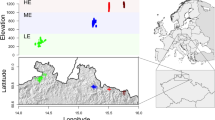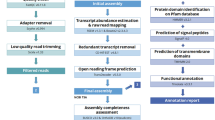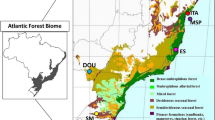Abstract
Eucalyptus globulus is an important species for pulpwood production in many countries. The pattern and partitioning of variation is important baseline knowledge for tree breeding. Currently the species is divided into four subspecies: globulus, bicostata, pseudoglobulus and maidenii. Random Amplified Polymorphic DNA (RAPD) markers were used to analyse variation in 173 representatives of 37 natural populations of E. globulus: 31 localities of ssp. globulus (148 individuals), two localities each of ssp. bicostata (nine individuals), ssp. maidenii (ten individuals) and ssp. pseudoglobulus (six individuals). Ten 10-mer primers amplified a total of 162 scorable bands, of which 149 (91.9 per cent) were polymorphic, AMOVA analysis of a Euclidean distance matrix based on presence/absence of polymorphic bands found most variation within localities, but significant differences between localities and regions. Principal components analysis (PCA) identified a major latitudinal cline in RAPD phenotype that differentiated southern Tasmanian localities from other ssp. globulus localities on mainland Australia. Many localities previously identified as intermediate between subspecies globulus and other subspecies in morphology were not intermediate in RAPD phenotype. In some cases regions which showed marked differentiation between localities in capsule and juvenile leaf morphology showed Utile RAPD differentiation between localities. RAPDs also provided new insights into the affinities of outlying localities. Although RAPD technology has not yet been applied to many forest tree species, patterns of variation were similar to those found in other outcrossing species studied using both RAPDs and other molecular markers.
Similar content being viewed by others
Article PDF
References
Borralho, N M G, Cotterill, P P, and Kanowski, P J. 1992a. Genetic parameters and gains expected from selection for dry weight in Eucalyptus globulus ssp. globulus in Portugal. Forest Sci, 38, 80–94.
Borralho, N M G, Kanowski, P J, and Cotterill, P P. 1992b. Genetic control of growth of Eucalyptus globulus in Portugal. Silvae Genet, 41, 39–45.
Carlson, J E, Tulsieram, L K, Glaubitz, J C, Luk, V W K, Kauffeldt, C, and Rutledge, R. 1991. Segregation of random amplified DNA markers in F1 progeny of conifers. Theor Appl Genet, 83, 194–200.
Chalmers, K J, Waugh, R, Spent, J I, Simons, A J, and Powell, W. 1992. Detection of genetic variation between and within populations of Gliricidia sepium and G. maculata using RAPD markers. Heredity, 69, 465–472.
Chippendale, G M. 1988. Eucalyptus, Angophora (Myrtaceae). Flora of Australia, vol. 19. Government Publishing Service, Canberra.
Dawson, I K, Chalmers, K J, Waugh, R, and Powell, W. 1993. Detection and analysis of genetic variation in Hordeum spontaneum populations from Israel using RAPD markers. Mol Ecol, 2, 151–159.
Doyle, J J, and Doyle, J L. 1990. Isolation of plant DNA from fresh tissue. Focus, 12, 13–14.
Excoffier, L, Smouse, P E, and Quattro, J M. 1992. Analysis of molecular variance inferred from metric distances among DNA haplotypes: application to human mitochondrial DNA restriction data. Genetics, 131, 479–491.
Fang, G, Hammer, S, and Grumet, R. 1992. A quick and inexpensive method for removing polysaccharides from plant genomic DNA. Biotechniques, 13, 52–55.
Grattapaglia, D, and Sederoff, R. 1994. Genetic linkage maps of Eucalyptus grandis and E. urophylla using a pseudo-testcross mapping strategy and RAPD markers. Genetics, 137, 1121–1137.
Hu, J, and Quiros, C F. 1991. Identification of broccoli and cauliflower cultivars with RAPD markers. Pl Cell Rep, 10, 505–511.
Huff, D R, Peakall, R, and Smouse, P E. 1993. RAPD variation within and among natural populations of outcrossing buffalograss [Buchloe dactyloides (Nutt.) Engelm.]. Theor Appl Genet, 86, 927–934.
Jordan, G J, Borralho, N M G, Tilyard, P, and Potts, B M. 1994. Identification of races in Eucalyptus globulus ssp. globulus for growth characteristics in Tasmania. Silvae Genet (in press).
Jordan, G J, Potts, B M, Kirkpatrick, J B, and Gardiner, C. 1993. Variation in the Eucalyptus globulus complex revisited. Aust J Bot, 41, 763–785.
Kazan, K, Manners, J M, and Cameron, D F. 1993. Inheritance of random amplified polymorphic DNA markers in an interspecific cross in the genus Stylosanthes. Genome, 36, 50–56.
Kirkpatrick, J B. 1974. The numerical and intraspecific taxonomy of Eucalyptus globulus Labill. (Myrtaceae). Bot J Linn Soc, 69, 89–104.
Kirkpatrick, J B. 1975a. Geographical variation in Eucalpytus globulus. Forestry and Timber Bureau Canberra Bulletin, No. 47. Australian Government Publishing Service, Canberra.
Kirkpatrick, J B. 1975b. Natural distribution of Eucalyptus globulus Labill. Aust Geog, 13, 22–35.
Klein-Lankhorst, R M, Vermunt, A, Weide, R, Liharska, T, and Zabel, P. 1991. Isolation of molecular markers for tomato (Lycopersicon esculentum) using random amplified polymorphic DNA (RAPD). Theor Appl Genet, 83, 108–114.
Landry, B S, Dextraze, L, and Boivin, G. 1993. Random amplified polymorphic DNA markers for DNA fingerprinting and genetic variability assessment of minute parasitic wasp species (Hymenoptera: Mymaridae and Trichogrammatidae) used in biological control programs of phytophagous insects. Genome, 36, 580–587.
Mailer, R J, Scarth, R, and Fristensky, B. 1994. Discrimination among cultivars of rapeseed (Brassica napus L.) using DNA polymorphisms amplified from arbitrary primers. Theor Appl Genet, 87, 697–704.
Moran, G F. 1992. Patterns of genetic diversity in Australian tree species. New Forests, 6, 49–66.
Muona, O_. 1990. Population genetics in forest tree improvement. In: A. H. D. Brown, M. T. Clegg, A. L. Kahler and B. S. Weir (eds) Plant Population Genetics, Breeding and Genetic Resources, pp. 282–298. Sinauer, Sunderland, MA.
Potts, B M, and Jordan, G J. 1994. The spatial pattern and scale of variation in Eucalyptus globulus Labill. ssp. globulus: variation in seedling abnormalities and early growth. Aust J Bot, 42, 471–492.
Puterka, G J, Black, W C, IV, Steiner, W M, and Burton, R L. 1993. Genetic variation and phylogenetic relationships among worldwide collections of the Russian wheat aphid, Diuraphis noxia (Mordvilko), inferred from allozyme and RAPD-PCR markers. Heredity, 70, 604–618.
SAS. 1988. SAS/STAT User's Guide for Personal Computers Release 6.03 edition. SAS Institute, Cary, NC.
Sneath, P H A, and Sokal, R R. 1973. Numerical Taxonomy W. H. Freeman, San Fransisco.
Sobral, B W S, and Honeycutt, R J. 1993. High output genetic mapping of polyploids using PCR-generated markers. Theor Appl Genet, 86, 105–112.
Volker, P, and Orme, K. 1988. Provenance trials of Eucalyptus globulus and related species in Tasmania. Australian Forestry, 51, 257–265.
Welsh, J, and McClelland, M. 1990. Fingerprinting genomes using PCR with arbitrary primers. Nucl Acids Res, 18, 7213–7218.
Williams, J G K, Kubelik, A R, Livak, K J, Rafalski, J A, and Tingey, S V. 1990. DNA polymorphisms amplified by arbitrary primers are useful as genetic markers. Nucl Acids Res, 18, 6531–6535.
Yu, L-X, and Nguyen, H T. 1994. Genetic variation detected with RAPD markers among upland and lowland rice cultivars (Oryza sativa L.). Theor Appl Genet, 87, 668–672.
Author information
Authors and Affiliations
Rights and permissions
About this article
Cite this article
Nesbitt, K., Potts, B., Vaillancourt, R. et al. Partitioning and distribution of RAPD variation in a forest tree species, Eucalyptus globulus (Myrtaceae). Heredity 74, 628–637 (1995). https://doi.org/10.1038/hdy.1995.86
Received:
Issue date:
DOI: https://doi.org/10.1038/hdy.1995.86
Keywords
This article is cited by
-
Development of microsatellite markers and their use in genetic diversity and population structure analysis in Casuarina
Tree Genetics & Genomes (2016)
-
Genetic purity and patterns of relationships among tropical highland adapted quality protein and normal maize inbred lines using microsatellite markers
Euphytica (2015)
-
Assessment of genetic diversity in indigenous turmeric (Curcuma longa) germplasm from India using molecular markers
Physiology and Molecular Biology of Plants (2015)
-
Comparative performance of Eucalyptus bicostata, E. globulus, E. maidenii and E. pseudoglobulus on three northern New Zealand sites
New Zealand Journal of Forestry Science (2013)
-
Progress in Myrtaceae genetics and genomics: Eucalyptus as the pivotal genus
Tree Genetics & Genomes (2012)



